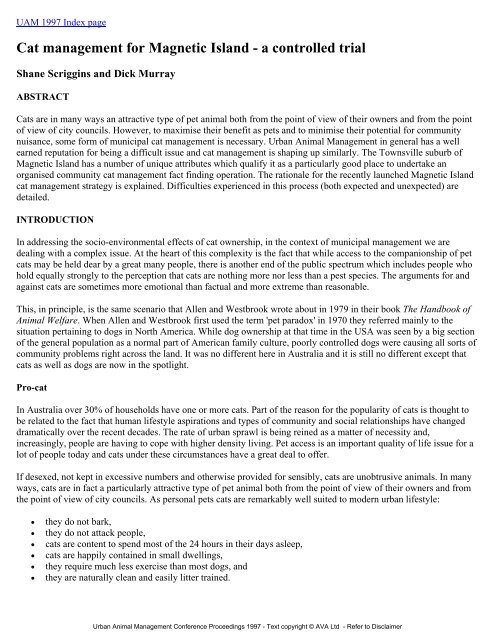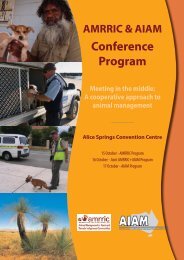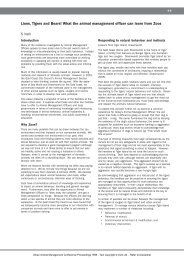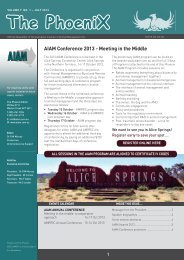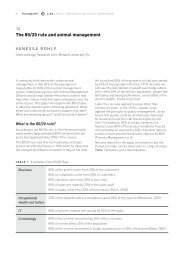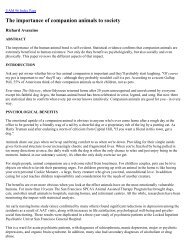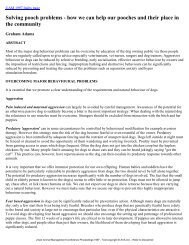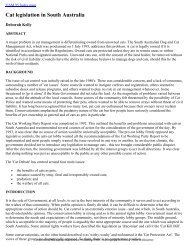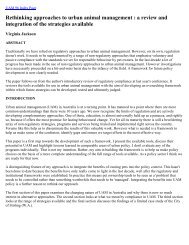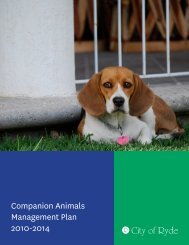Cat management for Magnetic Island - Australian Institute of Animal ...
Cat management for Magnetic Island - Australian Institute of Animal ...
Cat management for Magnetic Island - Australian Institute of Animal ...
Create successful ePaper yourself
Turn your PDF publications into a flip-book with our unique Google optimized e-Paper software.
UAM 1997 Index page<strong>Cat</strong> <strong>management</strong> <strong>for</strong> <strong>Magnetic</strong> <strong>Island</strong> - a controlled trialShane Scriggins and Dick MurrayABSTRACT<strong>Cat</strong>s are in many ways an attractive type <strong>of</strong> pet animal both from the point <strong>of</strong> view <strong>of</strong> their owners and from the point<strong>of</strong> view <strong>of</strong> city councils. However, to maximise their benefit as pets and to minimise their potential <strong>for</strong> communitynuisance, some <strong>for</strong>m <strong>of</strong> municipal cat <strong>management</strong> is necessary. Urban <strong>Animal</strong> Management in general has a wellearned reputation <strong>for</strong> being a difficult issue and cat <strong>management</strong> is shaping up similarly. The Townsville suburb <strong>of</strong><strong>Magnetic</strong> <strong>Island</strong> has a number <strong>of</strong> unique attributes which qualify it as a particularly good place to undertake anorganised community cat <strong>management</strong> fact finding operation. The rationale <strong>for</strong> the recently launched <strong>Magnetic</strong> <strong>Island</strong>cat <strong>management</strong> strategy is explained. Difficulties experienced in this process (both expected and unexpected) aredetailed.INTRODUCTIONIn addressing the socio-environmental effects <strong>of</strong> cat ownership, in the context <strong>of</strong> municipal <strong>management</strong> we aredealing with a complex issue. At the heart <strong>of</strong> this complexity is the fact that while access to the companionship <strong>of</strong> petcats may be held dear by a great many people, there is another end <strong>of</strong> the public spectrum which includes people whohold equally strongly to the perception that cats are nothing more nor less than a pest species. The arguments <strong>for</strong> andagainst cats are sometimes more emotional than factual and more extreme than reasonable.This, in principle, is the same scenario that Allen and Westbrook wrote about in 1979 in their book The Handbook <strong>of</strong><strong>Animal</strong> Welfare. When Allen and Westbrook first used the term 'pet paradox' in 1970 they referred mainly to thesituation pertaining to dogs in North America. While dog ownership at that time in the USA was seen by a big section<strong>of</strong> the general population as a normal part <strong>of</strong> American family culture, poorly controlled dogs were causing all sorts <strong>of</strong>community problems right across the land. It was no different here in Australia and it is still no different except thatcats as well as dogs are now in the spotlight.Pro-catIn Australia over 30% <strong>of</strong> households have one or more cats. Part <strong>of</strong> the reason <strong>for</strong> the popularity <strong>of</strong> cats is thought tobe related to the fact that human lifestyle aspirations and types <strong>of</strong> community and social relationships have changeddramatically over the recent decades. The rate <strong>of</strong> urban sprawl is being reined as a matter <strong>of</strong> necessity and,increasingly, people are having to cope with higher density living. Pet access is an important quality <strong>of</strong> life issue <strong>for</strong> alot <strong>of</strong> people today and cats under these circumstances have a great deal to <strong>of</strong>fer.If desexed, not kept in excessive numbers and otherwise provided <strong>for</strong> sensibly, cats are unobtrusive animals. In manyways, cats are in fact a particularly attractive type <strong>of</strong> pet animal both from the point <strong>of</strong> view <strong>of</strong> their owners and fromthe point <strong>of</strong> view <strong>of</strong> city councils. As personal pets cats are remarkably well suited to modern urban lifestyle:• they do not bark,• they do not attack people,• cats are content to spend most <strong>of</strong> the 24 hours in their days asleep,• cats are happily contained in small dwellings,• they require much less exercise than most dogs, and• they are naturally clean and easily litter trained.Urban <strong>Animal</strong> Management Conference Proceedings 1997 - Text copyright © AVA Ltd - Refer to Disclaimer
Anti-catThere are, however, a number <strong>of</strong> reasons <strong>for</strong> the pressing demands <strong>for</strong> community cat control in Australia. Theseproblem perceptions, if they are to be overcome, need to be addressed as rationally and sensibly as possible. Theyinclude specifically:• the public nuisance caused by roaming, intrusion and sexual behaviour <strong>of</strong> entire males and females;• animal welfare anxiety over the plight <strong>of</strong> unwanted cats;• public concern about the ecological impact on wildlife;• problems associated with species vilification and cruelty to cats; and• human health matters including cat related diseases.RESOLVING THE PARADOX - A TEST OF GOVERNANCEOver recent decades tangible benefits <strong>of</strong> better dog <strong>management</strong>, with respect to both animal welfare and generalcommunity quality <strong>of</strong> life, have been conclusively demonstrated. If we use the term 'community environment' toinclude both ecological as well as social components, dog <strong>management</strong> is now accepted to be a very significantcommunity environment issue. There is little doubt that municipalities with good dog control are better places inwhich to live. Both the people and the pets are better <strong>of</strong>f. <strong>Cat</strong>s are now also on the agenda and the same rationaleapplies.Like all aspects <strong>of</strong> municipal pet <strong>management</strong>, cat <strong>management</strong> is also a community issue. Councils can only ever dowhat the communities they represent want them to do - that's the reality. Councils who are interested in cat<strong>management</strong> there<strong>for</strong>e need to ensure community consultation be<strong>for</strong>e developing their strategy <strong>of</strong> cat <strong>management</strong>.• They need to think about the resources that will be necessary to implement the kinds <strong>of</strong> cat control measuresthey would like to see.• They need to settle on the approach that would seem most likely to be successful in their region.Most councils are familiar with the way in which any different or new suggestion about animal <strong>management</strong> is boundto create a storm <strong>of</strong> polarised community reaction. Most councils are also familiar with the way in which a very fewpeople can (<strong>for</strong> all sorts <strong>of</strong> personal reasons that may even be unrelated to this particular issue) create a degree <strong>of</strong>public turmoil that is completely out <strong>of</strong> step with majority wishes and expectations.Good governance in this particular community issue needs confidence and a steady hand. It is a situation wherecouncillors cannot af<strong>for</strong>d to be rattled by the first couple <strong>of</strong> angry dissenting voices.• It is wise to approach the task <strong>of</strong> municipal cat <strong>management</strong> with due circumspection.• It is wise to be prepared <strong>for</strong> some turmoil during the settling in period.At the end <strong>of</strong> the day a local electorate will only support a cat <strong>management</strong> strategy if the goals and methods <strong>of</strong> thatstrategy meet with majority community expectations. In consequence the first need, as cat <strong>management</strong> is approachedin earnest by local government, is <strong>for</strong> thorough investigation <strong>of</strong> public expectations by a process <strong>of</strong> communityconsultation.• Is it wanted by the majority?• What degree <strong>of</strong> regulation will be accepted?Urban <strong>Animal</strong> Management Conference Proceedings 1997 - Text copyright © AVA Ltd - Refer to Disclaimer
MAGNETIC ISLANDThe Townsville suburb <strong>of</strong> <strong>Magnetic</strong> <strong>Island</strong> has a number <strong>of</strong> unique attributes which qualify it as a particularly goodplace to undertake an organised community cat <strong>management</strong> fact finding operation. By 1994 a primafacie case <strong>for</strong> cat<strong>management</strong> on <strong>Magnetic</strong> <strong>Island</strong> existed <strong>for</strong> 3 main reasons:1. An ecologically important program <strong>of</strong> mandatory cat minimisation within the confines <strong>of</strong> the <strong>Magnetic</strong> <strong>Island</strong>National Park depended absolutely on cat control in adjoining residential areas.2. Widespread public concern had arisen on the island about the unlawful, unsanctioned and indiscriminatekilling <strong>of</strong> cats in places other than the National Park.3. The idea <strong>of</strong> cat <strong>management</strong> <strong>for</strong> the <strong>Island</strong>, and even some serious suggestion <strong>of</strong> cat eradication, had been put<strong>for</strong>ward strongly by some (number uncertain) <strong>of</strong> island residents.<strong>Magnetic</strong> <strong>Island</strong> has a human population <strong>of</strong> approximately 2,655 1 . It is an attractive study area because <strong>of</strong> themoderate community size, its National Park, its proximity to the rest <strong>of</strong> Townsville City, its physical separation fromthe mainland part <strong>of</strong> the city and its otherwise normal suburban status.There are 780 private households (400 in owned property and 380 rented) on <strong>Magnetic</strong> <strong>Island</strong>. The census lists another100 households living on boats or other similarly less fixed addresses. At the present time an unknown number <strong>of</strong>stray/feral cats also live on the island.Approximately 54% <strong>of</strong> the island is currently reserved and managed as a National Park by the QueenslandGovernment Department <strong>of</strong> Environment and Heritage. Residential and other <strong>for</strong>ms <strong>of</strong> freehold property almostsurround the <strong>Magnetic</strong> <strong>Island</strong> National Park.After discussing cat issues in the <strong>for</strong>um <strong>of</strong> the Council's Environment Consultative Committee on 10/12/93, thefollowing pathway <strong>for</strong> approaching cat <strong>management</strong> on <strong>Magnetic</strong> <strong>Island</strong> was initiated:1. Review the available literature on the subject <strong>of</strong> cat <strong>management</strong> and community cat problems.2. Prepare an appropriate <strong>management</strong> strategy rationale that is effective and af<strong>for</strong>dable <strong>for</strong> the council.3. Undertake a community survey to gather cat population details, gauge the opinions <strong>of</strong> residents about catissues and gauge acceptance <strong>of</strong> the key elements <strong>of</strong> a suite <strong>of</strong> tentative cat <strong>management</strong> suggestions (from 2).4. Implement a 12 month <strong>management</strong> trial on the basis <strong>of</strong> techniques approved by community feedback from thesurvey.5. Resurvey after approximately 12 months to compare cat population details and assess community impressions<strong>of</strong> the success or otherwise <strong>of</strong> the trial strategy.6. Reflect on the success (or otherwise) <strong>of</strong> the whole <strong>Magnetic</strong> <strong>Island</strong> cat <strong>management</strong> exercise with a view tointroducing an effective cat <strong>management</strong> policy <strong>for</strong> the entire City.1. Review and prepareThe work and the recommendations <strong>of</strong> the authors, Veitch (1991), Upton (1992), Wilson et al (1992), Wood (1992),Duncan (1993), Nattrass (1993), Pergl (1994), Kelly (1995), Penson (1995) and Webb (1995), was helpful indeveloping the cat <strong>management</strong> strategy that is now in place on <strong>Magnetic</strong> <strong>Island</strong>. Particular attention was paid to theSherbrooke experience (Pergl 1994). Every ef<strong>for</strong>t was made to make best use <strong>of</strong> this specific reference because <strong>of</strong> itslocal government ambience and its environmental background.2. Strategy rationalei. Recording pets and removing strays - the only place to startThe question <strong>of</strong> ownership and owner responsibility is central to any attempt at urban cat <strong>management</strong>. While otherissues may apply by way <strong>of</strong> system refinements, the first and most important step is the identification <strong>of</strong> ownership.Once the owner <strong>of</strong> an animal has been <strong>for</strong>mally identified, community expectations relating to reasonable restraint andcare can be encouraged and if necessary en<strong>for</strong>ced.Urban <strong>Animal</strong> Management Conference Proceedings 1997 - Text copyright © AVA Ltd - Refer to Disclaimer
Once an effective system <strong>of</strong> pet cat registration/recording has been put in place, steps can then be taken tosystematically gather up and remove all the rest - the strays.By being able to remove strays from municipal environs the total cat population can be reduced without treading onanyone's toes. Strays are a common source <strong>of</strong> municipal nuisance. They enjoy poor quality <strong>of</strong> life. They are a source<strong>of</strong> environmental and welfare anxiety.A stray eradication program, by itself, in one single step goes a long, long way towards the goal <strong>of</strong> overall effective cat<strong>management</strong>. By this device both public nuisance and total municipal cat population can be reduced withoutcompromising pet security or public pet access at all.However you look at it strays are better <strong>of</strong>f out <strong>of</strong> it altogether and, without wanting to put too finea point on it, the quicker the betterii. Strays and desexing - the next logical stepThe community nuisance caused by entire cats, with their propensity <strong>for</strong> wide ranging <strong>of</strong>fensive aggression, predatoryaggression, intrusive territorial behaviour (including urine marking) and their noisy sex oriented nocturnal behaviour,is universally recognised. As well as this, you don't have to be a rocket scientist to understand that entire roaming catsare a reliable source <strong>of</strong> unwanted kittens that are also heading straight <strong>for</strong> Straysville.Mature 'sexually intact' pet cats, though not exactly strays in the original sense, are to all intents and purposes birds <strong>of</strong>the same feather if they are allowed to roam. While reasonable pet cat owners accept this and do something abouteither desexing or confinement be<strong>for</strong>e the nonsense starts, others simply don't bother. If kept permanently confined bytheir owners, sexually capable cats are not a community problem. However if they are allowed to roam they mostcertainly are.iii. 'Gettable' goals - no point in anything elseThe main goals in the quest <strong>for</strong> effective municipal cat <strong>management</strong> are to eliminate strays and to desex or confine petcats to prevent them from being a public nuisance and a source <strong>of</strong> more strays. Practical ways have to be found tomake these goals 'gettable'. The chance <strong>of</strong> a conventional 'dog type' registration system, with a differential desexingincentive, proving successful <strong>for</strong> cats is none. It doesn't even work properly <strong>for</strong> dogs - and that's when compliance canbe checked, if necessary by door to door inquiry. The old dog control levers will not link through to give a result withcats.What's needed is entirely new methodology which ideally focuses not so much on regulation by inspection andprosecution but on the principle <strong>of</strong> community self regulation.<strong>Cat</strong>s behave differently to dogs and the problems they cause are different.It stands to reason that techniques <strong>for</strong> <strong>management</strong> will also have to be different.iv. Self regulation - self <strong>management</strong> - the final keyThe quality <strong>of</strong> local laws used in a self regulation framework needs to be good. It is the same <strong>for</strong> any law, but more so<strong>for</strong> local laws designed <strong>for</strong> self regulation. They need to be:• Definitive - no grey areas, minimum ifs and buts and maybes, clearly defined obligations and expectations <strong>for</strong>cat owners;• Meaningful - makes sense, easily understood why;• Reasonable - seen to give everybody, including pets, pet owners and others, a fair go;• Validatable - compliance (or noncompliance) able to be checked if the need should arise; and• En<strong>for</strong>ceable - effective penalties <strong>for</strong> noncompliance.Urban <strong>Animal</strong> Management Conference Proceedings 1997 - Text copyright © AVA Ltd - Refer to Disclaimer
example, while farm livestock may not be allowed to wander onto roadways where they can cause traffic hazards andproperty damage, council <strong>of</strong>ficers do not go out inspecting farm fence lines and checking the adequacy <strong>of</strong> individualbrand identification on cattle, sheep and horses. It is left to the farmers to ensure these things are done properly orsuffer the consequences if they are not. This is self regulation.• A recording system <strong>for</strong> pet cat identification with associated owner linking does in fact lend itself to theconcept <strong>of</strong> community self regulation. With a community self regulation approach in this situation council staffdo not have to check cat registrations as they do <strong>for</strong> dogs. In other words, cats can be recorded by their ownersrather than registered.• The onus <strong>of</strong> identification is entirely on the owners, not only to do it but to do it right as well. It can quitesimply be made clear in the relevant local law that any impounded cat showing no <strong>for</strong>mal (approved)registration/identification will <strong>of</strong>ficially be classified as a stray and that will be that.• A requirement <strong>for</strong> the desexing <strong>of</strong> pet cats is another option that lends itself to a self regulatory approach. Thebest pathway is to utilise the power <strong>of</strong> neighbourhood peer group pressure backed up in the local law by arequirement that entire cats over the age <strong>of</strong> 5 months can only be kept by people who hold a breeder's permitand must under no circumstances be allowed by the permit holder to be at large at any time.v. Linking the keys - the microchip 'key ring'Microchip technology <strong>of</strong>fers the obvious solution to this problem. Provided an '<strong>Australian</strong> reader base' standard is usedmicrochips <strong>of</strong>fer a reliable, af<strong>for</strong>dable, available and nationally uni<strong>for</strong>m method <strong>of</strong> identification <strong>for</strong> cats.'<strong>Australian</strong> reader base' standard must be used.Provided the microchips can be obtained by local veterinarians with a standard collar, bell and appropriate educationalmaterial, the advantages <strong>for</strong> local government are as follows:• council does not have to be mixed up in owner record database <strong>management</strong> - it is up to the microchip supplierto log the details - it is up to the pet owner to ensure the records are current and accurate;• council animal control <strong>of</strong>ficers can access the database any time via a 008 phone number if the need to contactan owner should arise;• council does not have to be involved in the distribution and implantation <strong>of</strong> the ID device/s - it is up toveterinary practices to supply and implant the microchips;• council does not have to bill anybody - the ID, implanting and registration database services are all supplied ona competitive fee <strong>for</strong> service basis direct to the pet owning clients; and• the council takes advantage <strong>of</strong> a pet owner education service that accesses all the recorded pet cat owners at thetime the microchip is implanted without any input at all from the public sector.vi. Public notice summaryThe following guidelines <strong>for</strong> cat owners can be clear and simple and published regularly:• pet cats must be identified by microchip and both their own and their owner's details recorded accurately in themicrochip supplier's national pet records database;• standard residential property allows the keeping <strong>of</strong> up to 2 cats per residence with permit constraints applyingto flats, units and situations exceeding the standard 2 cat limit;• pet cat owners are encouraged to provide their cats with conventional collars, ID discs and bells;• pet cats must, by the time their permanent canine teeth have erupted, be either desexed or be registered asbreeders and kept according to the council's cat breeder permit requirements;• the owners <strong>of</strong> pet cats should minimise and may, if required, have to prevent their cats trespassing ontoadjoining property;• the feeding <strong>of</strong> stray cats is discouraged absolutely.Urban <strong>Animal</strong> Management Conference Proceedings 1997 - Text copyright © AVA Ltd - Refer to Disclaimer
It is important that the <strong>management</strong> strategy should be (and should be seen to be) a fair and reasonable way <strong>of</strong>balancing the interests <strong>of</strong> everybody. While the plan is intended to actively control stray and feral cat numbers it isalso intended to equally actively protect the interests <strong>of</strong> people who wish to keep pet cats in a responsible way.While members <strong>of</strong> the general community are encouraged to assist the council in trapping strays this is only permittedunder conditions which keep the procedures <strong>for</strong> impounding and handling stray cats firmly in the hands <strong>of</strong> individualproperty occupiers and the Council:• only council's traps may be used with traps being checked out only to bonafide (identified) property occupiers -and only used <strong>for</strong> trapping on that occupier's own property;• trapping <strong>of</strong> stray cats in public open space in residential areas (parks, reserves, <strong>for</strong>eshore, crown land etc) onlyto be undertaken by council staff - coordinated where necessary with other relevant authorities (eg LandsDepartment).3. Survey Mandate And Other Community ConsultationIn 1995 a comprehensive community survey (<strong>Cat</strong>scan <strong>Magnetic</strong>) designed to gauge the public position on cat<strong>management</strong> <strong>for</strong> <strong>Magnetic</strong> <strong>Island</strong> was undertaken. Complete details <strong>of</strong> the methodology, the questionnaire and theresults (<strong>Cat</strong>scan <strong>Magnetic</strong> - final report: a survey <strong>of</strong> attitudes to cats and their <strong>management</strong>) have been published in thetext book, Dogs and <strong>Cat</strong>s in the Urban Environment 2 . The survey was arranged pr<strong>of</strong>essionally, the response was 71%and the results were conclusive.• Eighty three percent <strong>of</strong> respondents were in favour <strong>of</strong> a cat <strong>management</strong>, 11% were undecided and only 6% <strong>of</strong>respondents were against the idea <strong>of</strong> cat <strong>management</strong> on the <strong>Island</strong>. As a result <strong>of</strong> this response alone it wasdetermined by the council that a cat <strong>management</strong> plan could be <strong>for</strong>mulated <strong>for</strong> the residential areas on<strong>Magnetic</strong> <strong>Island</strong>. Further more, if the anticipated expenses were reasonable, a 'fair dinkum' strategy could beimplemented at least <strong>for</strong> a trial period <strong>of</strong> 12 months.• There was 92.3% community support <strong>for</strong> the trapping and humane disposal <strong>of</strong> stray and feral cats and 90%support <strong>for</strong> identification and recording <strong>of</strong> pet cats. There was no doubt that the strategy <strong>for</strong> the island couldaf<strong>for</strong>d the luxury <strong>of</strong> starting right from the beginning with these two essential strategy components.• There was 91.5% support <strong>for</strong> the idea <strong>of</strong> keeping breeding cats confined at all times and 93.2% support <strong>for</strong> thedesexing <strong>of</strong> non-breeding pet cats. There was no doubt that the majority <strong>of</strong> the island community wished toensure that pet cats on the island were desexed cats.In summary, the council's preliminary survey <strong>of</strong> island residents in every respect fulfilled the following requirements:• a community mandate <strong>for</strong> municipal cat <strong>management</strong> on the <strong>Island</strong> was evident;• a range <strong>of</strong> strategy options were approved by the community;• baseline zoographics and demographics were established.The <strong>Cat</strong>scan <strong>Magnetic</strong> final report (50 pages) was made available by the council from June 1995 to anyone whoexpressed interest in the results <strong>of</strong> the survey.4. Implement the strategyThe interval between the completion <strong>of</strong> the community survey and the introduction <strong>of</strong> the <strong>management</strong> trialitself was about two years. In this time, while the relevant local laws were being drawn up, the council itselfwas kept in<strong>for</strong>med on progress. Two public meetings were also convened on the island itself (Dec 96 and Feb97). All residents were advised by letter drop and invited to attend these meetings which were arranged toensure that, as far as was reasonably possible, the new policies and procedures relevant to cat <strong>management</strong>were well understood by all members <strong>of</strong> the community (including both 'pro' and 'anti' cat factions).Urban <strong>Animal</strong> Management Conference Proceedings 1997 - Text copyright © AVA Ltd - Refer to Disclaimer
LOOKING BACK - THE BENEFIT OF HINDSIGHTBearing in mind the benefit <strong>for</strong> Townsville City Council in being able to build on the experience <strong>of</strong> others such asVeitch (1991), Upton (1992), Wilson et al (1992), Wood (1992), Duncan (1993), Nattrass (1993), Pergl (1994), Kelly(1995), Penson (1995) and Webb (1995), this paper is in the same way intended to be <strong>of</strong> assistance to othermunicipalities that might undertake similar projects. There are a number <strong>of</strong> issues that stand out from our experience.While most people seem quite able to agree on what constitutes reasonable degrees <strong>of</strong> pet owner freedoms andconstraints with regard to cats there are those, in our experience, who find making any concessions towards the'middle ground' very difficult, if not completely impossible. Any council intending to undertake a cat <strong>management</strong>strategy should not be mistaken about this and should be prepared to deal with it.We believe that while the framework <strong>of</strong> local laws should be intended as a 'code' <strong>of</strong> reasonable and responsibleconduct it must also be en<strong>for</strong>ceable in every respect. People who harbour obsessive attitudes about cats can makethings very difficult <strong>for</strong> all the others who are prepared to sensibly agree to disagree and get on.Our experience is that the media has to be managed carefully when changes in either policy or practice <strong>of</strong> any pet<strong>management</strong> issue are in the wind. The media criticism in this case came at the point <strong>of</strong> launch when things were mostsensitive. The criticism was <strong>of</strong> an inflammatory nature and centred mainly around the allegation that the council hadincompetently handled the process <strong>of</strong> community consultation. This was a bitter pill to swallow <strong>for</strong> those who hadbeen involved since it was hard to see how the community consultation process could have been handled better(especially when the lion's share <strong>of</strong> the whole ef<strong>for</strong>t had in fact been carried out by voluntary workers).It would undoubtedly have been illuminating if the last comment could have been made by the Bush Stone Curlews <strong>of</strong><strong>Magnetic</strong> <strong>Island</strong>. Curlews are something <strong>of</strong> a 'flag carrier' native wildlife species on the <strong>Island</strong>. The most commonreason <strong>for</strong> support <strong>of</strong> a cat <strong>management</strong> plan was concern <strong>for</strong> the well being <strong>of</strong> this species (and other wildlife withless prominent pr<strong>of</strong>iles). At about the same time this plan was being put into effect, a mortality report <strong>for</strong> Curlews waspublished in the local press 4 . Of the most recent 91 recorded Curlew deaths 63 (70%) were road kills. It is intriguing towonder what the Curlews themselves would want to see happen in the interests <strong>of</strong> wildlife security. It seemsreasonable to assume that they might actually prefer, more than anything else, to see people give up their cars.REFERENCES AND OTHER READINGAllen, R.D. and Westbrook, W.H. 1979. The Pet Paradox in The Handbook <strong>of</strong> <strong>Animal</strong> Welfare - Biomedical,Psychological, and Ecological aspects <strong>of</strong> Pet Problems and Control, pp.3-13 (eds R.D. Allen and W.H. Westbrook),Garland STPM Press, New York and London.Barratt, D. 1994. Using Theory and Scientific Experience to a Assess the Impact <strong>of</strong> House-Based Domestic <strong>Cat</strong>s Feliscatus (L.) on Prey Populations and Prey Community Structure in the Proceedings <strong>of</strong> the Third National Conference onUrban <strong>Animal</strong> Management in Australia, pp. 148-156 (Ed. Paxton, D.W.), The <strong>Australian</strong> Veterinary Association, POBox 371 ARTARMON 2064, The <strong>Australian</strong> Veterinary Association, PO Box 371 ARTARMON 2064.Carr, G.M. and Macdonald, D.W. 1986. The Sociality <strong>of</strong> Solitary <strong>for</strong>agers: A Model Based on Resource Dispersion,Anim. Behav. 34: 1540.Duncan, M. 1993. The interaction <strong>of</strong> Domestic and Feral <strong>Cat</strong>s with Native Wildlife and The Warringah Council 'Role<strong>of</strong> Pets in the Community' - A Pilot Survey.Kelly, D. 1995. <strong>Cat</strong> Legislation in South Australia in the Proceedings <strong>of</strong> the Fourth National Conference on Urban<strong>Animal</strong> Management in Australia, pp. 133-139 (Ed. Paxton, D.W. and Boland, P), The <strong>Australian</strong> VeterinaryAssociation, PO Box 371 ARTARMON 2064, The <strong>Australian</strong> Veterinary Association, PO Box 371 ARTARMON2064.Liberg, O. 1984. Home Range and Territoriality in Free Ranging House <strong>Cat</strong>s Acta Zool. Fennica 17: 283.Urban <strong>Animal</strong> Management Conference Proceedings 1997 - Text copyright © AVA Ltd - Refer to Disclaimer
Nattrass, R. 1993. A Model <strong>for</strong> <strong>Cat</strong> Control in the Proceedings <strong>of</strong> the Second National Conference on Urban <strong>Animal</strong>Management in Australia, pp. 30-37 (Ed. Paxton, D.W.), The <strong>Australian</strong> Veterinary Association, PO Box 371ARTARMON 2064.Paton, D.C. 1990. Domestic <strong>Cat</strong>s and Wildlife Bird Observer, 696: 34.Penson, P. 1995. Victorian <strong>Cat</strong> Legislation in the Proceedings <strong>of</strong> the Fourth National Conference on Urban <strong>Animal</strong>Management in Australia, pp. 129-132 (Ed. Paxton, D.W. and Boland, P), The <strong>Australian</strong> Veterinary Association, POBox 371 ARTARMON 2064,pergl, G. 1994. The Sherbrooke <strong>Cat</strong> Law - Does it work? in the Proceedings <strong>of</strong> the Third National Conference onUrban <strong>Animal</strong> Management in Australia, pp. 183-187 (Ed. Paxton, D.W.), The <strong>Australian</strong> Veterinary Association, POBox 371 ARTARMON 2064.Petcare In<strong>for</strong>mation and Advisory Service 1983. <strong>Cat</strong> Ownership in Australia: An Attitude and Opinion Study, PetcareIn<strong>for</strong>mation and Advisory Service, 117 Collins Street, Mellbourne, Victoria 3000.Serpell, J.A. 1988. The Domestication and History <strong>of</strong> the <strong>Cat</strong> in The Domestic <strong>Cat</strong> - The Biology <strong>of</strong> its Behaviour, pp.151-158 (Eds. Turner, D.C and Bateson, P.), Cambridge University Press, Cambridge CB2 IRP, England.South <strong>Australian</strong> Department <strong>of</strong> Environment and Planning 1992. <strong>Cat</strong> Working Party Report p1. Department <strong>of</strong>Environment and Planning, 55 Grenfell Street, Adelaide 5000.Tideman, C. 1994. Do <strong>Cat</strong>s Impact on Wildlife? in the Proceedings <strong>of</strong> the Third National Conference on Urban<strong>Animal</strong> Management in Australia, pp. 141-147 (Ed. Paxton, D.W.), The <strong>Australian</strong> Veterinary Association, PO Box371 ARTARMON 2064, The <strong>Australian</strong> Veterinary Association, PO Box 371 ARTARMON 2064.Turner, D.C. and Meister, O. 1993. Hunting Behaviour <strong>of</strong> the Domestic <strong>Cat</strong> in The Domestic <strong>Cat</strong> - The Biology <strong>of</strong> itsBehaviour, pp. 151-158 (Eds. Turner, D.C and Bateson, P.), Cambridge University Press, Cambridge CB2 IRP,England.Upton, B. 1992. <strong>Animal</strong> Shelter Management, <strong>Animal</strong> Control and <strong>Animal</strong> Welfare in Proceedings <strong>of</strong> the FirstNational Conference on Urban <strong>Animal</strong> Management in Australia, Ed. Murray, R.W. p.138. Chiron Media, PO Box 69Mooloolah, 4553.Veitch, C.R. 1985. Methods <strong>of</strong> Eradicating Feral <strong>Cat</strong>s from Offshore <strong>Island</strong>s in New Zealand ICBP TechnicalPublication No.3.Veitch, C.R. 1991. <strong>Cat</strong> Eradication: The New Zealand Perspective in The Proceedings <strong>of</strong> the Workshop on the Impact<strong>of</strong> <strong>Cat</strong>s on Native Wildlife, pp. 82-89 (Ed Potter, C.), Endangered Species Unit, <strong>Australian</strong> National Parks andWildlife Service, Canberra, December, 1991.Vines, G. 1993. Secret Power <strong>of</strong> Pets New Scientist #1894, Oct. 1993, pp 30-34.Webb, C. 1995. Management <strong>of</strong> Unowned <strong>Cat</strong> Colonies in the Proceedings <strong>of</strong> the Fourth National Conference onUrban <strong>Animal</strong> Management in Australia, pp. 37-48 (Ed. Paxton, D.W. and Boland, P), The <strong>Australian</strong> VeterinaryAssociation, PO Box 371 ARTARMON 2064, The <strong>Australian</strong> Veterinary Association, PO Box 371 ARTARMON2064.Wilson, G., Dexter, N., O'Brien, P. and Bom<strong>for</strong>d, M. 1992. Feral <strong>Cat</strong> (Felis catus) in Pest <strong>Animal</strong>s in Australia: ASurvey <strong>of</strong> Introduced Wild Mammals, pp. 55-57, Bureau <strong>of</strong> Rural Resources, Department <strong>of</strong> Primary Industries andEnergy, Canberra.Urban <strong>Animal</strong> Management Conference Proceedings 1997 - Text copyright © AVA Ltd - Refer to Disclaimer
Wood, D. 1992. Domestic and Free Ranging <strong>Cat</strong>s in Ku-ring-gai - Domestic <strong>Cat</strong> and Wild Life Questionnaire Kuring-gaiMunicipal Council, 818 Pacific Highway, GORDON, NSW 2072.__________________Footnotes1 The Townsville Region, A Social Atlas, 3rd ed. 19932 ISBN 0 9586784 1 3, written by RW Murray and HE Penridge and published by Chiron Media (1997)3 Central <strong>Animal</strong> Records (suppliers <strong>of</strong> the TROVAN microchip)4 <strong>Magnetic</strong> Community News Vol 8, Issue 41, 18th June '97ABOUT THE AUTHORShane ScrigginsTownsville City CouncilPO BOX 1268TOWNSVILLE QLD 4810Ph: (077) 220481Fx: (077) 220464Shane Scriggins started working in animal control with the Brisbane City Council in 1983. Shane obtained his TAFECertificate <strong>of</strong> <strong>Animal</strong> Control Practices qualification, his TAFE Certificate <strong>of</strong> Business Management and is currentlyworking on his TAFE Certificate <strong>of</strong> Local Government majoring in animal <strong>management</strong>. He is presently employed asTechnical Officer (animal <strong>management</strong>) by the Townsville City Council. The cat <strong>management</strong> trial explained in thispaper was developed by both authors with the assistance <strong>of</strong> contributing members <strong>of</strong> the <strong>Island</strong> community, otherCouncil <strong>of</strong>ficers and the deputy mayor, Ann Bunnell. Details relevant to the background <strong>of</strong> his co-author in this paper(Dick Murray) are included in the paper Best practice in Municipal Pet Management - in<strong>for</strong>mation access is the key tocompetitive efficiency in both governance and service delivery elsewhere in this proceedings publication.UAM 1997 Index pageUrban <strong>Animal</strong> Management Conference Proceedings 1997 - Text copyright © AVA Ltd - Refer to Disclaimer


